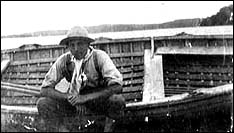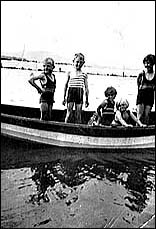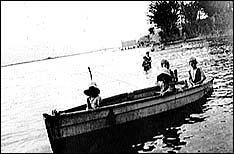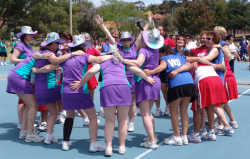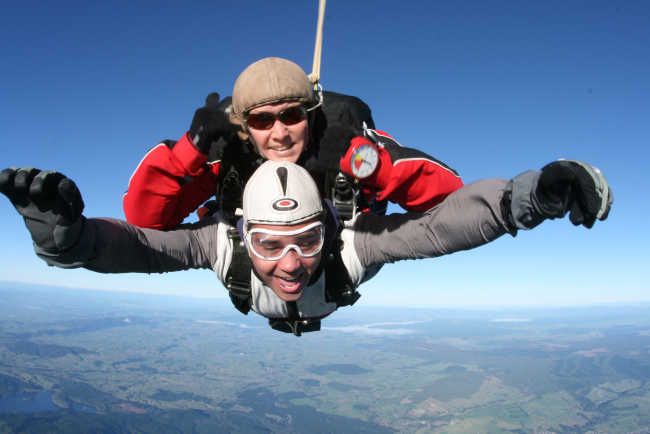Part 10 – Nowhere Far From The Sea Four Fishermen – 19/01/01
You can read the previous part in the Growing up in New Zealand 1925 – 1950 series here, or read the articles from the original Growing Up in New Zealand series.
As Basil Dowling said in one of his poems, wherever you are in New Zealand you are ‘nowhere far from the sea’. Spending time in boats and fishing from the wharf or the shore have always been popular pastimes for New Zealanders. For most growing up between 1925 and 1950 the boats were not elaborate or expensive. The most popular was the clinker-built dinghy. This type of boat is made of wooden planks each of which is laid to overlap the one below forming a series of longitudinal ledges.
|
|
|
|
|
| Clinker-Built Dinghies |
Four people shared their memories of fishing…
Warwick went fishing near Auckland The older I get, the more I appreciate having been born and grown up in New Zealand. We were truly privileged. A child doesn’t worry about sophisticated lifestyles, which appeal to some adults. As a boy, apart from the usual games, I enjoyed so much those things which nature had to offer. The countryside was a trampers ideal, with no worries of snake, spiders, wild animals or other characters of that ilk. We could tramp all day, then pick a nice spot to roll out the sleeping bag, light a fire to fry a steak and to boil some veges and a billy for tea. I can still recall places I have camped in years ago. One in particular was on the top of Mt. Pihanga at the southern end of Lake Taupo. We woke to a calm and crisp morning with a light frost on our sleeping bags, below a beautiful blue sky with wisps of cloud streaking above the lake, which lay as a blue sea below us. We lay for a while before starting breakfast, warm in our bags, savouring the view and at the same time listening to the donging reverberations of a bellbird calling his good-morning song. Memories like that never fade away.
The land offered us many such beauties, but the sea surrounding the land had formed an equally beautiful coastline with many magnificent beaches and its waters were full of fish. Even though the population of the whole country is still very small, more and more of our beaches are becoming overpopulated. Some of my happiest days were spent in a small boat patiently fishing for those plentiful fish. My old friend Ron, who was like a second father to me, had a beach house – a bach, as we called all beach houses in those days. It was built on the beach which formed a boundary of a farm owned by a friend of his. The farmer’s family had worked the dairy farm for several generations, but now, sadly, it has gone to ‘development’ and is now subdivided. The beach front on which Ron’s bach was the only building, is now covered in beach houses, pushing side by side against the next door neighbour.
Once again I am thankful for my memories. In those days I was just one of those beach seagulls, which scoured the beach at low tide. The tide would go out a long way and when out would then show where the schnapper had made their holes ‘digging’ for shall fish. So when the tide was in I would take a net and drag through the water for ‘sprats’ which we used for bait to catch larger fish. I would also row the dinghy out to set the net off the point to catch mullet or other fish cruising the coastline or I would just row out in the dinghy to fish with a hand line.
The dinghy was a small boat and could be anything from 6 feet to 12 feet in length. They were most commonly Clinker-built but were sometimes Carvill-built, which was very strong but much heavier. The Clinker boat was made by overlapping lengths of timber about 4 to 6 inches wide and about half an inch thick, which were all nailed to a frame of ribs using copper nails. The Carvil construction used carefully shaped lengths of timber about 1 inch by 1 inch and these were butted against each other, giving a smooth outer skin. Later on, when marine plywood became available, this offered a fast and alternative method of boat construction, but it lacked that elegance of a clinker!
The clinker boat I used was light and very manoeuvrable. It had three seats and two sets of rowlock blocks. You selected which position to use according to the passenger list and the amount of the load in the boat. Unlike canoes you row a dinghy with your back facing the direction in which you are moving, with an oar in each hand. It was always easy to identify an experienced oarsman by their long steady pull on the oars and the uncanny ability to row in a direct line which contrasted with the splashes and erratic movement, in all directions, of the novice. But there was no other way to get there in those days and it certainly was good exercise even if the hands and buttocks became blistered in the process. It did take time, however, and when the first small ‘Seagull’ outboard engines arrived, with only 2 horsepower capacity to push them along, I must admit to a certain envy at their speed in comparison to my 1 manpower capacity.
We would row out about a mile or more from the beach until we reached the spot, located by lining up such features as island or shore features, and then we would get out the hand lines and we would fish. And I do mean fish. We caught so many fish that we would share with all of our neighbours and it didn’t matter at all that it might have taken us an hour or more to row out and an equal time to return. We could spare the time and still have an abundant catch.
But for me, rowing has one prime feature which an engine can never replace. It is QUIET! All the way out and all the way back, the only sounds to be hears, apart from our conversation, were the chunk/thunk of the oars in the rowlocks and the creaming and splashing of the water as the boat moved along. It was peaceful to me, and is far more pleasant than that eternal engine noise which suppresses all other sound and even makes conversation difficult. Then there is one other thing that you cannot do if you have an outboard engine or a propeller whizzing around under the stern – and that is to set a net from the stern of a dinghy.
There was a river mouth near to the beach and we would often row up the river and set a net off one of the mangrove heads, partially blocking the tributary. Then we would come down behind the net, making a noise and splashing the water to move the flounder. Once again a marvellous memory of those days !! In one such catch we pulled in 82 flounder in the net over the stern. Once again the neighbourhood was well supplied. It was a long haul to get back home that night but I didn’t even mind the blisters.
For Warwick’s more recent experiences at sea, read ‘Cruising, Fishing, Diving in Dusky Sound’
Peter recalls fishing near Nelson "Would you like to go fishing at Cable Bay this weekend?" Dad asked. My brother and I naturally jumped at the suggestion.
"Can we take Jim?" I asked and it was agreed that my good friend Jim could come too.
Cable Bay Cable Bay which is about thirty kilometres out of Nelson has a place in our family’s mythology. Dad had started his working life there about 1905 by joining the ‘Eastern Extension Cable Co’, later to become ‘Cables and Wireless’. In those days an overseas cable came ashore there – hence the name – and there was quite a staff at the station. Local boys had a great opportunity to see the world if they joined the company. At that time it was relatively isolated and recreation had to be found nearby. There were tennis courts – and there was the SEA. Dad used both, but fishing had the added benefit of providing a change of diet, so all the staff there became very knowledgeable about where and how to catch fish.
Fishing trips require preparation, so we started by checking the gear – first the dinghy, a 12 foot clinker built craft, and trailer, then the oars and rowlocks, bailer, fishing lines, bait, anchor and ropes, suitable footwear, and sacks to sit on and to enclose any fish we caught. No life jackets then, so we had to be extra careful, but we could all swim.
On the day Dad set the alarm for about 4.30 am and we were not enthusiastic about tumbling out of bed at that hour, but he had tea and toast ready for us. Like all fishermen Dad had his theories about the best time to fish. His was that the best time was at low tide when this occurred early in the morning.
By the time we arrived at the Bay it was daylight and the sun was coming up. The water was quite calm and the sky was blue. Impatiently we unloaded and launched the boat, parked the car and trailer, loaded the gear aboard and pushed off.
Two of us boys rowed with Dad indicating where to head – "Row left" or "Row right" etc. When we reached the end of the Rocky Point off Pepin Island to the east of Cable Bay Dad manoeuvred us to a likely location and we dropped anchor.
Once the boat had settled we shipped the oars, got out our lines, baited the hooks and dropped them over the gunwale. Almost immediately we started getting bites, not a lot, but certainly enough to be interesting. Dad caught the first fish, a blue cod. Then Jim caught one too, but it was only a ‘spotty’. The bites continued and the sun was sparkling off the water. It was an idyllic morning.
We caught another couple of fish but both were rather small. We decided to try a different place, so up came the lines, carefully coiled in the bottom of the boat in such a way that they would not tangle. Then Jim pulled up the anchor and we rowed slowly to a place a little further to sea.
We dropped anchor again and in due course had our lines at the bottom again. Here we got some really promising bites. Alister pulled in a red cod and I got a blue cod. This was great.
Suddenly Dad shouted, "Pull up your lines!" We were flabbergasted. We were just getting what we had come for. Dad saw our hesitation and he became quite fierce in repeating the demand. He added, "Look at the horizon!" Instead of a smooth line the water showed jagged edges. Clearly there was a rough sea arriving.
We did not mess about any more and we were soon rowing as fast as possible back to the beach at the Bay. By the time we got there the tide had come in quite a long way and a moderate swell was making rowing quite difficult.
Beaching a boat in these conditions is a problem as the waves tend to turn the boat side on and there is risk of capsizing. We made our plan, and then waiting for a suitable wave we rowed towards the beach.
We could feel the waves lift us and turn us sideways. We rowed furiously to keep the bow to the shore and the stern to sea. In spite of our best efforts we tilted frighteningly sideways. Several times we managed to correct it and finally we were able to get to the beach.
The person in the bow leapt out with the painter and pulled hard. The waves continued to make things difficult, but the rest of us were able to scramble out, and we pulled the boat to safety but got pretty wet in the process.
The waves became worse after that and we were very glad to be ashore again. We had some fish and had had an instructive adventure.
You always have to be alert when you are at sea in a small boat.
Alex recalls his fishing expeditions on the east coast of the North Island. I went fishing at Kairakau Beach and Maungakuri Beach in an area with a small tidal range. Part was sandy but there were also large stretches of rocky platform with pools full of seaweed. My brother and I would walk through the pools at low tide and fish for paua and crayfish. Sometimes we fished by hand with our heads under water without wearing our goggles. The only diving equipment we had was goggles and snorkels.
Our rods were home made, but with my rod I caught rock cod, parrot fish and spotties. In the rock pools I used a net and caught butterfish.
People used to make crayfish pots out of interlaced supplejack and Number 8 wire – that nearly universal Kiwi solution to construction problems. There was a funnel neck and a hole at the top. Paua or fish bait was used, or sometimes even old mutton. At the beginning of summer the crayfish were plentiful.
Once I was twelve or thirteen I would go fishing without my elder brother, though it was a dangerous coast with no shelter and consequently not popular for boating. People get washed off rocks when fishing but in the hundreds of hours I spent fishing I never saw a threatening wave. I think that the East Coast is actually less dangerous than the West Coast.
I’m still an enthusiastic fisherman but now I prefer to fish in Lake Taupo.
Alister remembers fishing at Kokoroa near Nelson. We stayed in an old whare (hut) at Kokoroa at the mouth of the Whangamoa River, an estuarine area with extensive mudflats.
At this site we tried various types of fishing. We used hand nets to catch whitebait, and fished off the rocks for cod. We tried spearing fish but didn’t have much success.
We could set nets across some of the subsidiary channels and catch flounder. We had a clinker-built ten foot dinghy. Three of us could carry it from the car trailer down a steep bank to a flat meadow beside the hut. We would put the net on the back seat of the boat and row down a subsidiary channel of the river at low tide to choose a site for the net. We would hammer in stakes and set the net across the channel at high tide. The water at high tide would cause a curve in the net. Towards low tide, four or five hours later we would find fish in and near the net and put them in a sack near the boat. At the end of the trip my father would take some of the catch to the local Maori.
I’ll never forget the time my friend and I were rowing flat out up the river fighting the current and hit a log which went through the bow of the boat, making a hole just above the water line. We were NOT popular.
Readers, do share with us some of your fishing experiences in the years between 1925 and 1950.

